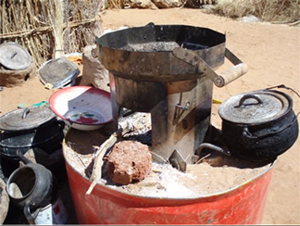Disaster recoverySafe, efficient cookstoves for earthquake survivors
316,000 people were killed and more than one million made homeless by the 12 January 2010 magnitude 7.0 quake that left the capital city of Port-au-Prince in ruins; many of the displaced Haitians still live in tent cities, where even simple tasks such as cooking are a challenge; scientists hope to find the safest and most energy-efficient way for earthquake survivors to cook

The Berkeley-Darfur energy efficient cookstove // Source: lbl.gov
The developers of the fuel-efficient Berkeley-Darfur Stove for refugee camps in central Africa are at it again, this time evaluating inexpensive metal cookstoves for the displaced survivors of last year’s deadly earthquake in Haiti.
Scientists from the U.S. Department of Energy’s Lawrence Berkeley National Laboratory (Berkeley Lab) have teamed up with students from the University of California, Berkeley to run a series of efficiency tests comparing the traditional Haiti cookstove with a variety of low-cost, commercially available alternatives (see Cookstove Project). A Lawrence Berkeley National Lab release reports that the long-term goal is to find the safest and most fuel-efficient stove — or to design a new one that would win favor with the cooks of Haiti — and tap the resources of nonprofit aid organizations to subsidize its manufacture in local metal shops.
“A more efficient cookstove would not only save Haitian families and aid organizations money on fuel, but could also reduce pressure to cut down trees in this already heavily deforested island nation,” says Haiti Stove Project leader Ashok Gadgil, director of the Environmental Energy Technologies Division at Berkeley Lab and the driving force behind development of the Berkeley-Darfur stove. “More efficient stoves that emit less carbon monoxide and smoke could also help reduce the adverse impacts of these emissions on the health of the cooks in Haiti, who are mostly women.”
The Haitian government estimates that 316,000 people were killed and more than one million made homeless by the 12 January, 2010 magnitude 7.0 quake that left the capital city of Port-au-Prince in ruins (although some international organizations estimate the casualties to be lower). That suffering and devastation was readily apparent when Gadgil sent a team to Haiti three months after the quake on a mission to evaluate the need for cookstoves among survivors.
Their findings underscored both the promise and challenges facing any attempt to apply the Darfur cookstove experience to the Haitian situation. “The Darfur stove is a wood-burning stove. It didn’t work as well in Haiti, where most people cook with charcoal,’’ says UC Berkeley combustion engineering graduate student Katee Lask, who is supervising the stove-testing. “Since there were already so many charcoal stoves on the market, we decided to look at the ones that were already being disseminated there and provide an unbiased assessment. This is valuable information for the nongovernmental organizations, or NGOs, who do not have the technical capacity for
